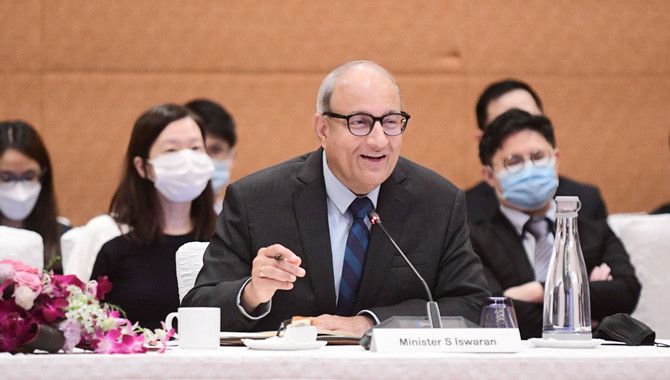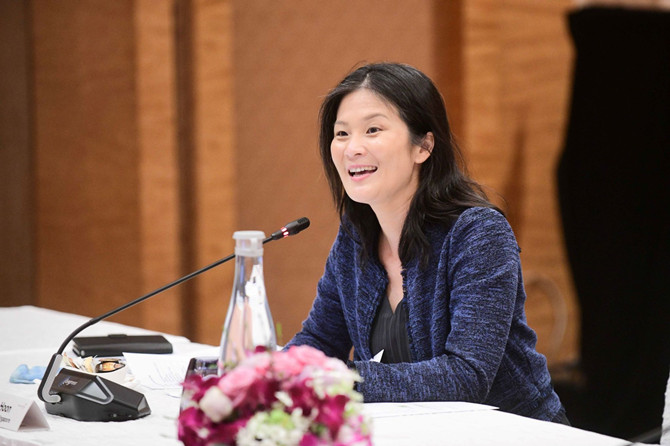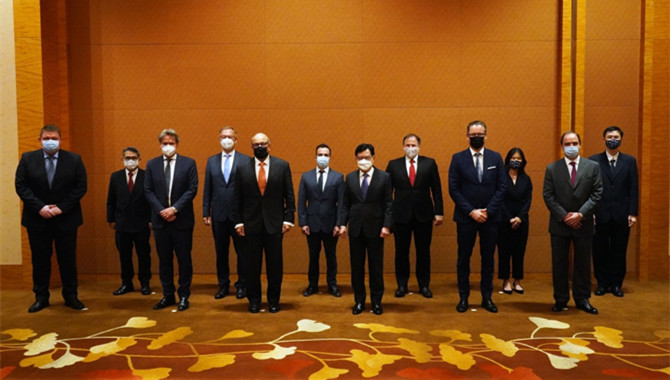
The Maritime International Advisory Panel (IAP), chaired by Minister for Transport and Minister-in-charge of Trade Relations Mr S Iswaran, held its inaugural meeting on 5 and 6 April during the Singapore Maritime Week 2022. The Maritime IAP was set up by the Ministry of Transport (MOT) and the Maritime and Port Authority of Singapore (MPA) and comprises global business leaders from the maritime sector and adjacent industries. It aims to seek global perspectives on key trends that will shape the maritime industry, and how the maritime sector and adjacent industries can collaborate to enhance the connectivity and resilience of the global maritime industry and supply chains.
Over the two days, the Maritime IAP held insightful discussions with Singapore's Deputy Prime Minister and Coordinating Minister for Economic Policies, Mr Heng Swee Keat, and Mr S Iswaran on the future of the global economy, trade and supply chains. They also visited the Port of Singapore and had a deeper discussion with Mr S Iswaran on the critical factors as well as the stakeholder collaborations needed to build connected, resilient and sustainable supply chains.

Global Trends
The Maritime IAP highlighted three key trends that would shape the future of a resilient and sustainable supply chain:
1. Reconfiguration of supply chains through diversification, regionalisation and disintermediation, due to growing emphasis by countries and companies on the need to enhance resilience and flexibility amidst the COVID-19 pandemic and geopolitical developments;
2. Technological advancements, such as digitalisation and automation, which would improve productivity and end-to-end visibility of supply chains; and
3. Growing importance of sustainability as countries, corporations and consumers demand a decisive response to climate change.
Enabling More Connected, Resilient and Sustainable Supply Chains
Shipping is a critical conduit for global trade. In response to the three trends, the Maritime IAP emphasised the important leadership role of maritime hubs around the world, including Maritime Singapore, in enabling more connected, resilient and sustainable supply chains.
The Maritime IAP underscored the need for inclusive collaboration among governments, the maritime industry, and adjacent sectors across the global supply chain to accelerate solutioning and scale up efforts; thereby complementing and reinforcing the efforts undertaken by the International Maritime Organization (IMO).
The Maritime IAP identified the building of digital corridors and green corridors as two areas for collaboration.

Digital Corridors
Companies and countries are increasingly seeking end-to-end visibility across supply chains to enable better management, responsiveness, and optimisation of complex supply chains. The emergence of technologies such as Internet of Things technologies, digital twins, blockchains and predictive analytics can drive accurate and timely data flows to enable better integration of supply chains and more agile responses to disruptions.
The Maritime IAP stressed the importance of advancing digital solutions to strengthen supply chain resilience. In particular, the panel recommended the following areas for collaboration with the aim of improving visibility across supply chains:
1. Data sharing particularly of non-commercially sensitive data can be facilitated via common platforms.
2. Data standardisation and interoperability can be enhanced to facilitate access to reliable and real-time data.
3. Data security can be strengthened to safeguard the use of data across the supply chains from the potential risk of increasing cyberattacks.
By focusing on these areas, digital corridors among the industry, adjacent sectors and governments can be developed to enable trusted, secure and seamless information flow across global supply chains.
Green Corridors
The Maritime IAP noted that there was urgency to tackle carbon emissions in shipping. On the shipside investments required, the Maritime IAP recommended further engagement with shipyards and engine makers to explore modular development of vessels that would provide flexibility.
Given that significant investments will be required to build infrastructure to support future fuels bunkering, the Maritime IAP noted the need to balance between narrowing down and catering for a few viable fuel solutions in the nearer term, and retaining flexibility to respond to technological advances in this area. The Maritime IAP noted the global shipping industry’s proposal to the IMO to establish a fund to accelerate decarbonisation financed through mandatory financial contributions for marine fuel oil consumed. This would provide funds to accelerate research and development (R&D) in low- and zero-carbon fuel solutions and incentivise the transition to greener shipping while supporting capacity-building for developing countries’ climate action. The Maritime IAP discussed that Singapore, as a major transhipment hub and bunkering port, could play a role in developing and piloting such a funding mechanism. The pilot would complement the work of the IMO.
The Maritime IAP viewed the availability of green financing for shipping as important to support decarbonisation. To encourage the development of green financing, the Maritime IAP suggested a finance ecosystem to bring together players with the funds and match available projects based on their risk levels. To enable better assessment of the risks, specialised players from the legal and accounting services sector can be involved to plug the knowledge gap.
The Maritime IAP suggested that coalitions of the willing can shape the future of decarbonisation by establishing green corridors. Such green corridors would serve as pilots to demonstrate how key ecosystems, including regulatory sandboxes for new fuels, green financing, information sharing, and carbon accounting mechanisms, can be brought together to provide practical ways to decarbonise the maritime industry.
The Maritime IAP agreed that the development of such initiatives should complement the work done at the IMO and be inclusive to ensure that the maritime sector could make the green transition together. Bold action at the multilateral, regional and bilateral fronts amongst stakeholders such as maritime and port authorities, industry players, and research institutions was necessary to accelerate decarbonisation efforts. The Maritime IAP viewed that Maritime Singapore is well placed to foster such collaborations across ecosystems, sectors and borders by leveraging Singapore’s position as a hub of hubs for maritime, aviation, trading, finance, talent, and innovation.
Critical Role Played by Seafarers
The Maritime IAP underscored the critical role seafarers played in keeping global supply chains flowing and delivering essential goods to the world. The Maritime IAP expressed the hope that countries around the world continue to support seafarers out at sea.
Mr S Iswaran said, “We thank the IAP members for their valuable insights on how we can collaborate to bolster the connectivity, resilience and sustainability of global supply chains. As a trusted global maritime hub, Maritime Singapore will continue to drive collaborations with like-minded partners so as to create a digital and green future of maritime together.”
The opinions expressed herein are the author's and not necessarily those of The Xinde Marine News.
Please Contact Us at:
media@xindemarine.com




 Ningbo Containerized Freight Index Weekly Commentar
Ningbo Containerized Freight Index Weekly Commentar  Ningbo Containerized Freight Index Weekly Commentar
Ningbo Containerized Freight Index Weekly Commentar  Ningbo Containerized Freight Index Weekly Commentar
Ningbo Containerized Freight Index Weekly Commentar  BIMCO Shipping Number of the Week: Bulker newbuildi
BIMCO Shipping Number of the Week: Bulker newbuildi  Ningbo Containerized Freight Index Weekly Commentar
Ningbo Containerized Freight Index Weekly Commentar  Ningbo Containerized Freight Index Weekly Commentar
Ningbo Containerized Freight Index Weekly Commentar